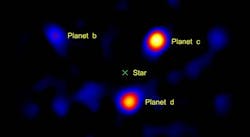Pasadena, CA--Astronomers have captured an image of three exoplanets orbiting a young star 129 light years away. What is remarkable is that the image was acquired using a telescope mirror apertured to only 1.5 m diameter. The feat was accomplished by a team at NASA's Jet Propulsion Laboratory (JPL; Pasadena, CA), using a small portion of the Palomar Observatory's Hale Telescope, north of San Diego.1
The planets have been imaged previously by two of the world's biggest ground-based telescopes—one of the two 10 m telescopes of W.M. Keck Observatory and the 8 m Gemini North Observatory, both on Mauna Kea in Hawaii. The planets, which orbit the star HR 8799, were among the first to be directly imaged, a discovery announced in November of 2008.
Vortex coronograph
The new image of the planets was taken in IR light as before. The astronomy team combined two techniques—adaptive optics and a coronagraph—to minimize the glare from the star and reveal the dim glow of the much fainter planets. A novel vortex coronagraph, invented by team member Dimitri Mawet of JPL, was used for this step; the coronograph applies a phase spiral to the focal plane. The nearest planet to the star is separated from the star by only two diffraction beamwidths.
"Our technique could be used on larger ground-based telescopes to image planets that are much closer to their stars, or it could be used on small space telescopes to find possible Earth-like worlds near bright stars," said Gene Serabyn, an astrophysicist at JPL and visiting associate in physics at the California Institute of Technology in Pasadena.
The three planets, called HR8799b, c and d, are thought to be gas giants similar to Jupiter, but more massive. They orbit their host star at roughly 24, 38 and 68 times the distance between our Earth and sun, respectively (our Jupiter resides at about five times the Earth-sun distance). It's possible that rocky worlds like Earth circle closer to the planets' star, but with current technology, they would be impossible to see in the star's glare.
The star HR 8799 is a bit more massive than our sun, and much younger, at about 60 million years, compared to our sun's approximately 4.6 billion years.
Keeping telescopes small is critical for space missions. "This is the kind of technology that could let us image other Earths," said Wesley Traub, the chief scientist for NASA's Exoplanet Exploration Program at JPL. "We are on our way toward getting a picture of another pale blue dot in space."
Larger apertures will require next-generation adaptive optics
Take a look at the image and see how well the coronograph eliminates the light from the star itself—very impressive. For use with larger-aperture ground-based telescopes, however, the coronograph will have to be paired with next-generation adaptive-optics systems, say the researchers.
REFERENCE
1. E. Serabyn et al., Nature, Vol. 464, 15 April 2010, doi:10.1038/nature09007
About the Author
John Wallace
Senior Technical Editor (1998-2022)
John Wallace was with Laser Focus World for nearly 25 years, retiring in late June 2022. He obtained a bachelor's degree in mechanical engineering and physics at Rutgers University and a master's in optical engineering at the University of Rochester. Before becoming an editor, John worked as an engineer at RCA, Exxon, Eastman Kodak, and GCA Corporation.

